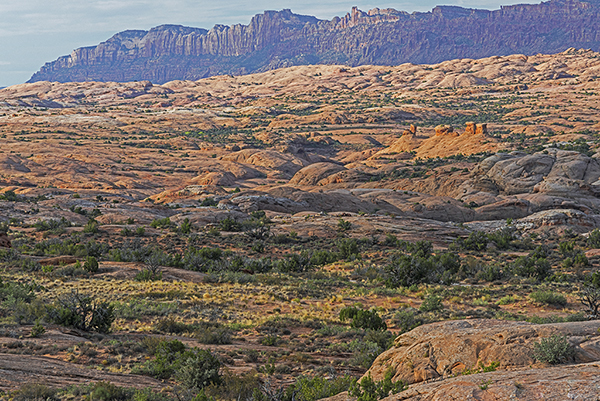The Moab Fault is a North-South running scar through which runs a major highway heading from Douglas, Arizona on the border with Mexico all the way to Yellowstone National Park in southwestern Wyoming. On the tableland beyond the eastern rise of the fault lies the vast spread of Arches National Park. The great western wall of the fault overlooks all of this, as it opens to the run of the Colorado River and the bustling tourist mecca of Moab (as in Biblical notoriety).
Like so many other areas on the Colorado Plateau, the tableland is deep with remnants of Navajo sandstone, the frozen sand dunes laid down in the Hettangian-Sinemurian stages of Jurassic time some 199-190Ma before the present. It is yet another wonderful example of the extent of geological diversity with which we have been so richly blessed.
In the warm light of a July morning I arrived quite early at the park and wound my way to a spot between the Great Wall and Balanced Rock. Perched on a high spot of stone and looking a bit southwest I saw spread before me layer upon layer of frozen dune, broken over the millennia into a thin veneer of cryptobiotic soil supportive of desert life. The warmth of the light was an experience I will always remember. A focal length of 230mm gave me the angle-of-view I wanted, with the uplift of the Moab Fault in the background looking my way and the swale of Courthouse Wash in between. An aperture of f/20 provided depth-of-field and a shutter speed of 15th second at ISO 200 gave me an overall medium exposure.
Arches National Park is one of Utah’s Big 5 National Parks. Its visitation has increased tremendously in the past ten years. It is amazing public land that we must work to preserve and protect or its resources will undergo the threats faced by many of our common lands, primarily the degradation of extreme over-visitation.

Just another beautiful picture
Hey Michael, it’s good the hear from you. Thanks very much for joining me. Would it not be wonderful if it were always just that simple? I guess the only thing to be said is that with continued practice, it does get easier to see the Beauty. Hope you have been well and safe. Spring is on the way.
Yes, another beautiful picture with an interesting geography lesson. I always enjoy both. You captured quite a lot of information with the 230mm focal length. A wide angle from that position would have way too much information. Thanks for pointing out the Courthouse; it looked familiar… like I had seen it in an earlier post.
You have so many interesting blog posts, I don’t think you will have any problem getting enough material for your book. Thanks for sharing.
Hi Nancy T. Isn’t it great when photography offers us something beyond just a pretty picture. I think that’s why I love it as I do. I had to look at the metadata twice to make sure I was seeing the focal length accurately; and you are so right about a true wide-angle being too much information. I guess that says something about the expansiveness of the Arches landscape. I trust you are safe and well in West Tennessee. Will plan to talk soon.
Thanks to both of you for being with me for this conversation. I really appreciate that you both pay such close attention to the visual world and the Beauty it so readily shares with all of us. Where would we be on this journey called life if we did not have the light of Beauty to guide our path? May we always seek that light and be grateful for its presence.